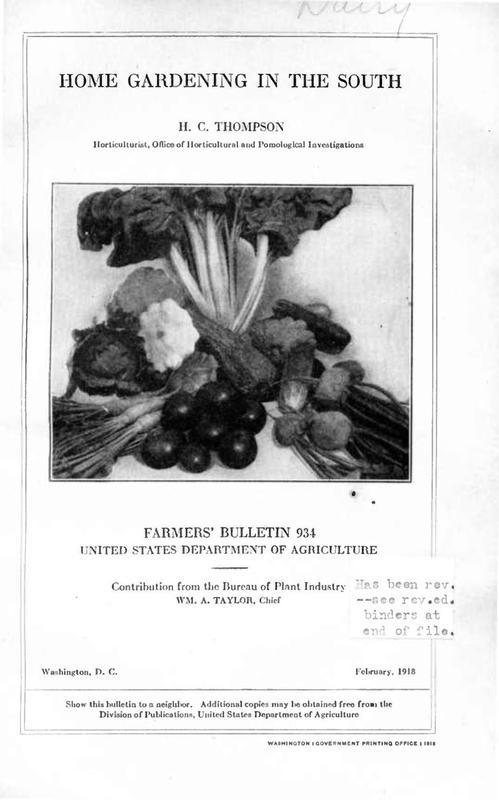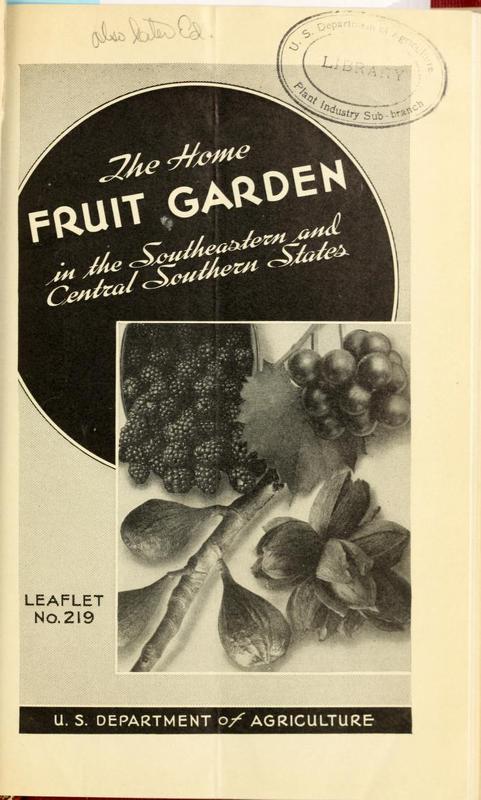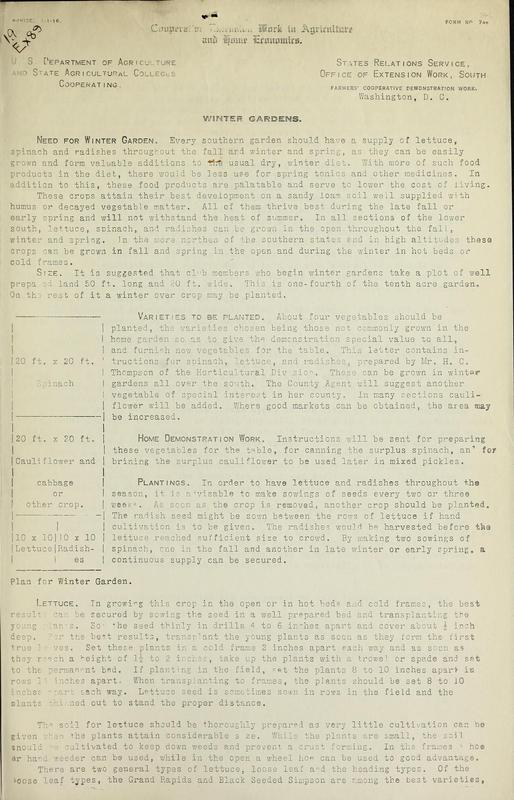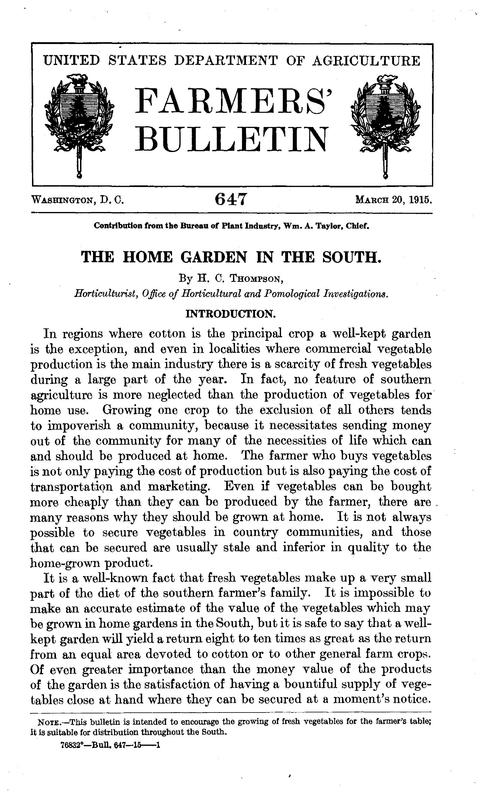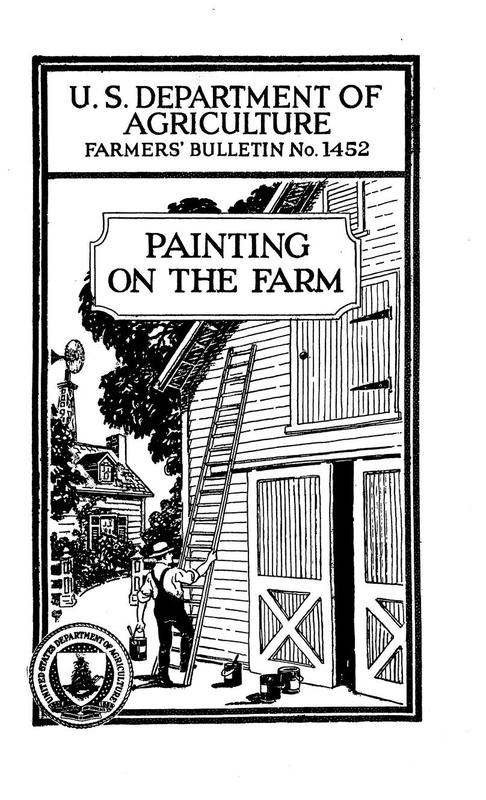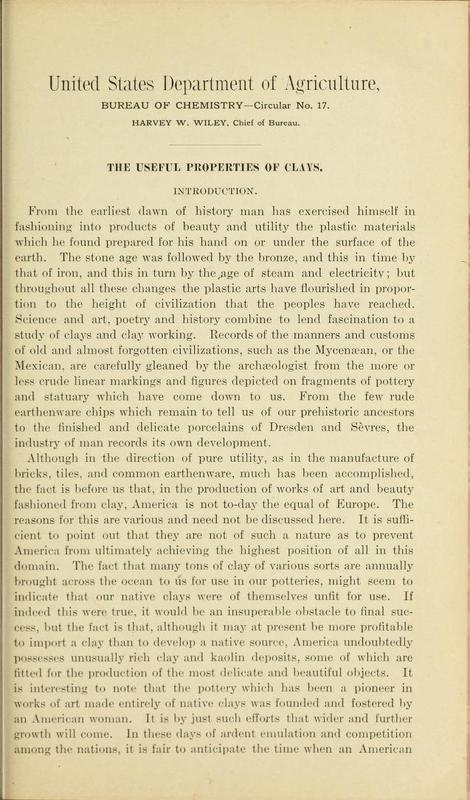USDA Historical Publications on Home Improvements
The U.S. Department of Agriculture has also supported the small farmer in his or her efforts to beautify the home and immediate surroundings.
Here is a small sample of publications on farm gardens and home improvement methods published around the time of George Washington Carver's work at Tuskegee Institute.
(Click any image in this exhibit to get more information, including access to full text)
"A well-kept vegetable garden is a source not only of profit to the gardener but of pleasure to the entire family. For many vegetables which deteriorate rapidly in quality after being gathered, the only practicable means of securing the best is to grow them at home. This is especially true of garden peas, sweet corn, string beans, green Lima beans, and asparagus.
The land utilized for the farm garden, if well cared for, yields much larger returns than any area of similar size planted to the usual farm crops. A half acre garden should produce as much in money value as 2 or 3 acres in general farm crops.
In most sections of the South, though vegetables can be grown in nearly every month of the year, the garden is neglected; in fact, no feature of southern agriculture is more neglected than the production of vegetables for home use.
In the following pages specific instructions are given for making a garden and caring for it throughout the season."
"Well-ripened, sound fruits increase the healthfulness, variety, attractiveness, and palatability of meals. Despite the relatively large available supplies of fruit, many families, especially on farms, do not have adequate quantities in the diet. In almost every part of this region certain fruits and nuts that usually need little or no spraying can be grown successfully in farm or suburban fruit gardens. Fruits that need spraying are not so well suited for home production. By properly selecting the kinds and varieties for home planting, a succession of fresh fruit of high dessert quality can be available during much of the summer, and surpluses may be canned, preserved, dried, or in some cases frozen for use during other seasons. Such home consumption of fruits, together with purchases of kinds that cannot be grown successfully, should improve the diet and general health.
This leaflet lists the best kinds and varieties of fruits and nuts for home planting in the southeastern United States and gives brief directions for their care. Detailed information can be obtained from the State agricultural extension service or agricultural college."
"Every southern garden should have a supply of lettuce, spinach and radishes throughout the fall and winter and spring, as they can be easily grown and form valuable additions to the usual dry, winter diet. With more of such food products in the diet, there would be less use for spring tonics and other medicines. In addition to this, these food products are palatable and serve to lower the cost of living.
These crops attain their best development on a sandy loam soil well supplied with humus or decayed vegetable matter. All of them thrive best, during the late fall or early spring and will not withstand the heat of summer. In all sections of the lower south, lettuce, spinach, and radishes can be grown in the open throughout the fall, winter and spring. In the more northern of the southern states and in high altitudes these crops can be grown in fall and spring in the open and during the winter in hot beds or cold frames.
Size. It is suggested that club members who begin winter gardens take a plot of well prepared land 50 ft. long and 20 ft. wide. This is one-fourth of the tenth acre garden. On the rest of it a winter over crop may be planted. Planted, the varieties chosen being those not commonly grown in the home garden so as to give the demonstration special value to all, and furnish new vegetables for the table. This letter contains instructions for spinach, lettuce, and radishes, prepared by Mr. H. C. Thompson of the Horticultural Division. These can be grown in winter gardens all over the south. The County Agent will suggest another vegetable of special interest in her county. In many sections cauliflower will be added. Where good markets can be obtained, the area may be increased."
"The growing of a tenth-acre garden is a part of the regular four-year program of work of enrolled members of Girls' Gardening and Canning Clubs of the Southern States, and 87,705 such gardens were grown in 1918. In addition, 26,249 twentieth-acre garden plots were grown by junior club members and 221,925 home gardens by women and girls.
Since many of these girls have had no previous experience in gardening, they ask for definite instruction in caring for their gardens. This circular has been prepared to meet this need and is the first of the instruction letters sent to all club members to be used by them during their entire year's work. It contains information on selecting the location of the garden plot, and instructions in growing tomatoes, beans, and okra in the tenth-acre garden.
Farmers' Bulletin 934, Home Gardening in the South, gives further information on gardening.
To Gardening and Canning Club Members:
This circular contains rules for beginning work, instructions for selecting the tenth-acre garden plot and preparation of the soil, setting the plants, and cultivating the garden. Later you will be sent a circular on tomato diseases and insect pests.
Please keep these circulars; read the instructions carefully and refer to them often. You will thus be sure that you are following directions.
Your county agent will give you a daily record book and teach you how to keep it. Begin writing in this book as soon as you do your first work and continue making notes each time you do any work. Write to your county home-demonstration agent if you need further information."
"In regions where cotton is the principal crop a well-kept garden is the exception, and even in localities where commercial vegetable production is the main industry there is a scarcity of fresh vegetables during a large part of the year. In fact, no feature of southern agriculture is more neglected than the production of vegetables for home use. Growing one crop to the exclusion of all others tends to impoverish a community, because it necessitates sending money out of the community for many of the necessities of life which can and should be produced at home. The farmer who buys vegetables is not only paying the cost of production but is also paying the cost of transportation and marketing. Even if vegetables can be bought more cheaply than they can be produced by the farmer, there are many reasons why they should be grown at home. It is not always possible to secure vegetables in country communities, and those that can be secured are usually stale and inferior in quality to the home-grown product.
It is a well-known fact that fresh vegetables make up a very small part of the diet of the southern farmer's family. It is impossible to make an accurate estimate of the value of the vegetables which may be grown in home gardens in the South, but it is safe to say that a well- kept garden will yield a return eight to ten times as great as the return from an equal area devoted to cotton or to other general farm crops. Of even greater importance than the money value of the products of the garden is the satisfaction of having a bountiful supply of vegetables close at hand where they can be secured at a moment's notice."
"Instructions have already gone out for the winter garden and this letter simply follows up that one that you may know the many ways of using the vegetables suggested to be planted in the winter garden. Also the methods for taking care of any surplus you may have."
"Although a coat of paint adds greatly to the appearance of a building or a piece of farm machinery, the chief purpose of painting on the farm is to preserve houses, barns, and implements from the effects of the weather. Interior painting is usually done to make the home more attractive, but it also serves a useful purpose in making walls and ceilings more sanitary and dark rooms lighter.
The importance of painting has grown as the increasing cost of building materials has made it necessary to replace with less durable materials the wood and metal formerly used. Some woods, like white pine, yellow poplar, cypress, and cedar, and some metals, like wrought iron, zinc, copper, and brass, withstand the effects of exposure to the weather remarkably well and will last a long time with few or no applications of paint. The materials widely used to-day, such as yellow pine, cast iron, and the more common steels, however, deteriorate rapidly on exposure and need to be painted frequently. Even sheet iron that has been tinned or galvanized to prevent rusting usually should be painted because of imperfections in the coating.
Painting at regular intervals is the cheapest way to keep buildings and implements in good condition."
"From the earliest dawn of history man has exercised himself in fashioning into products of beauty and utility the plastic materials which he found prepared for his hand on or under the surface of the earth. The stone age was followed by the bronze, and this in time by that of iron, and this in turn by the age of steam and electricity; but throughout all these changes the plastic arts have nourished in proportion to the height of civilization that the peoples have reached.
Science and art, poetry and history combine to lend fascination to a study of clays and clay working. Records of the manners and customs of old and almost forgotten civilizations, such as the Mycensean, or the Mexican, are carefully gleaned by the archaeologist from the more or less crude linear markings and figures depicted on fragments of pottery and statuary which have come down to us. From the few rude earthenware chips which remain to tell us of our prehistoric ancestors to the finished and delicate porcelains of Dresden and Sevres, the industry of man records its own development."
 An official website of the United States government.
An official website of the United States government.


